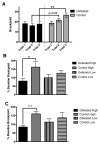Modeling hypohedonia following repeated social defeat: Individual vulnerability and dopaminergic involvement
- PMID: 28433467
- PMCID: PMC5524559
- DOI: 10.1016/j.physbeh.2017.04.016
Modeling hypohedonia following repeated social defeat: Individual vulnerability and dopaminergic involvement
Abstract
Social defeat in rodents putatively can model hypohedonia. The present studies examined models for assessing hypohedonia-like behavior and tested the hypotheses that 1) individual differences in baseline reward sensitivity predict vulnerability, and 2) defeat elicits changes in pharmacological measures of striatal dopaminergic function. Male Wistar rats (n=142) received repeated defeat (3 "triad" blocks of 3 defeats) or control handling. To determine whether defeat influenced consumption of SuperSac (glucose-saccharin) over an isocaloric, less preferred, glucose solution, a 2-choice paradigm was used. To determine repeated defeat effects on the reinforcing efficacy of SuperSac, a progressive-ratio schedule of reinforcement was used. Amphetamine-induced locomotor activity (0.08mg/kg, s.c.) was determined as a measure sensitive to striatal dopaminergic function. Defeat reduced SuperSac consumption during the first two triads-an effect seen in the third triad only in defeated rats with High vs. Low baseline SuperSac intake. The characteristic escalation in PR breakpoint for SuperSac normally seen in controls was absent in defeated rats, leading to a significant difference by the third triad. Defeat-induced blunting of the escalation in PR performance was greater in rats with High antecedent PR breakpoints and persisted 2.5weeks post-defeat. Repeated defeat also blunted amphetamine-induced locomotion 13days post-defeat. Thus, hypohedonic-like effects of social defeat were detected and accompanied by persistently attenuated striatal dopamine function. Early effects were seen for consumption of differentially-palatable solutions, and persistent effects were seen for the "breakpoint" motivational measure. The results implicate initial reward sensitivity as a risk factor for stress-induced hypohedonia.
Keywords: Amphetamine or dopamine reuptake inhibitor or dopaminergic; Anhedonia or anhedonic or hypohedonia or reward; Major depression or depressive or depressed; Motivation or volition or avolition; Repeated or chronic defeat or social stress; Sugar or glucose or saccharin or SuperSac.
Copyright © 2017 Elsevier Inc. All rights reserved.
Figures



References
-
- Allan S, Gilbert P. Submissive behaviour and psychopathology. Br J Clin Psychol. 1997;36(Pt 4):467–488. - PubMed
-
- Arnold JM, Roberts DC. A critique of fixed and progressive ratio schedules used to examine the neural substrates of drug reinforcement. Pharmacol Biochem Behav. 1997;57(3):441–7. - PubMed
-
- Bergamini G, Cathomas F, Auer S, Sigrist H, Seifritz E, Patterson M, Gabriel C, Pryce CR. Mouse psychosocial stress reduces motivation and cognitive function in operant reward tests: A model for reward pathology with effects of agomelatine. Eur Neuropsychopharmacol. 2016;26(9):1448–1464. - PubMed
MeSH terms
Substances
Grants and funding
LinkOut - more resources
Full Text Sources
Other Literature Sources
Research Materials

